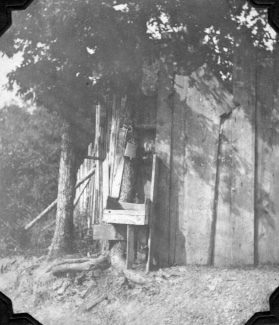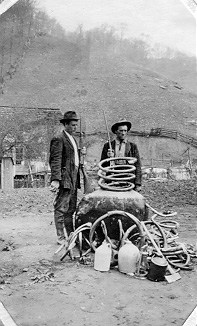

Thirsty travellers could ring the bell in this tree, take a little stroll, then return to find a drink waiting for them. After quenching their thirst, travellers would put some money in the tree, then move on. From the John C. and Olive Campell Collection, Southern Historical Collection, University of North Carolina
As far as the government is concerned, the real problem with moonshine isn't making it, but selling it.
Once moonshine is sold the government misses out on the tax revenue it collects on legally distilled liquor. This battle to collect taxes, and the moonshiners determination to avoid paying them, is at the heart of much of the struggle between moonshiners and the law.
Traditionally, moonshiners sell by word-of-mouth, and on a local scale. People in search of moonshine have to look for it, and look in the right places. The bell tree shown to the right is an example of a traditional means of buying and selling moonshine.
Once moonshiners start selling on a larger scale, though, the means of delivering the product change somewhat. The liquor must travel further to get from the point of production to the consumer. This process usually involves driving the moonshine in a car or truck, and is known as bootlegging.
Over the years, bootleggers devised a number of ways to try to avoid capture while transporting their liquor. One of the most common was to enhance, or "soup up" the engines of the cars they drove. It has been theorized that this practice helped lead to the rise of stock car racing in the South.
Scene from "Thunder Road"
The main character (Robert Mitchum) eludes a "revenuer" in a moonlight car chase.
Moonshine by Memphis Minnie
Moonshiner and His Money by Charlie Bowman
Carolina Moonshine by Al Hopkins and His Buckle Busters

A mother and her children in moonshine country; many moonshiners were far from rich. From the John C. and Olive Campell Collection, Southern Historical Collection, University of North Carolina
The government estimated that there were approximately 2,000 stills in the Carolinas, Georgia, Virginia and Tennessee in 1877. Assuming they operated 20 days a month, 4 months a year, and produced 15 gallons a day, federal agents concluded that by selling illegal, untaxed liquor, moonshiners were depriving the federal government of $2,500,000 a year in uncollected taxes.
Legal distillers paid the revenue tax, were regulated by the government. Moonshiners, who didn't pay, were adamant about keeping the government out of their business. Many saw it as family tradition, a skill or trade passed on from father to son. They latched onto the concepts of natural rights and republicanism of the kind that had sparked many of the protests against British rule, the "no taxation without representation" battle cry of 100 years earlier.
State-level Prohibition increased the pressure on moonshiners, as they were pursued by both federal and state officials. It also forced moonshiners to expand their markets in many cases; if they were going to supply more and more people, they had to transport the liquor further and further afield.
By 1916, North Carolina, South Carolina, Tennessee, Virginia, Georgia and West Virginia were all officially "dry" states. This meant moonshining was increasingly becoming a big business, with bootleggers, the people who transported the liquor, playing a bigger and bigger role in the process.
Before Prohibition, moonshiners often sold their product relatively locally, relying on lumber and mining camps, textile mill villages and larger towns such as county seats to provide the bulk of their customers. Many of their customers were too poor to drink regularly or heavily.

A captured moonshine still. From the John C. and Olive Campell Collection, Southern Historical Collection, University of North Carolina
Long before the 18th Amendment outlawed the sale and consumption of alcohol in America, prohibition and moonshine had already formed an uneasy relationship.
Starting in the late 1870's the prohibition or temperance movements began to slowly seep into the South, town by town or county by county. By the 1890's the movement was gaining strength nationally, a fact that aided moonshiners tremendously. If a town outlawed the legal sale of liquor, the demand for moonshiners and their product became even greater. Prohibition reached much of the South on a state-wide level in the early twentieth century.
Prohibition also helped lower the standards of many moonshiners, the emphasis became quantity of liquor that could be produced with the quality taking a backseat. Faced with little alternative, thirsty drinkers were often not very discriminating and accepted "mean whiskey".
Prohibition movements changed the focus of the battle against moonshine. It was no longer just about taxation and collecting revenue, it was now about elimating liquor altogether, and was thus as much a moral war as it was an economic one. This proved to be a much harder task for both federal and local agents, and it only got more difficult with the rise of national Prohibition that became law with the passing of the 18th Amendment.